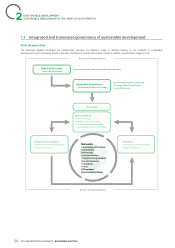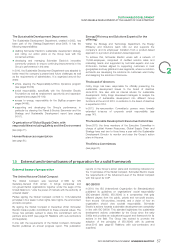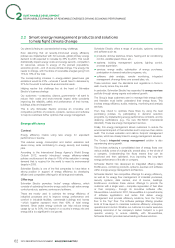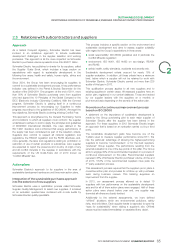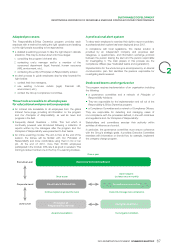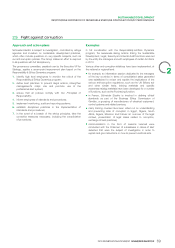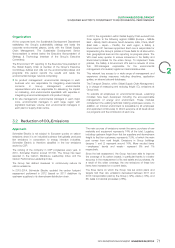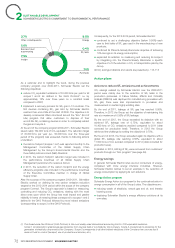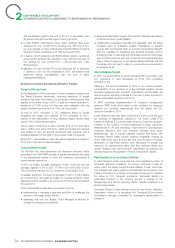APC 2013 Annual Report Download - page 67
Download and view the complete annual report
Please find page 67 of the 2013 APC annual report below. You can navigate through the pages in the report by either clicking on the pages listed below, or by using the keyword search tool below to find specific information within the annual report.
SUSTAINABLE DEVELOPMENT
RESPONSIBLE EXPANSION OF RENEWABLE ENERGIES DRIVING ECONOMIC PERFORMANCE
Relations with subcontractors and suppliers
2.3
Approach
This process includes a specific section on the environment and
sustainable development and aims to assess supplier suitability
As a Global Compact signatory, Schneider Electric has been with regard to the Group’s expectations in three areas:
involved in an ambitious approach to include sustainable social responsibility: ISO26000 guidelines and in particular the
l
development challenges in the supplier selection and working Conflict Minerals regulation;
processes. This approach is all the more important as Schneider
environment: ISO14001, ISO14062 on eco-design, REACH
l
Electric’s purchases volume represents more than EUR11billion.
and RoHS;
Schneider Electric has published a charter for its suppliers, called
2
safety: health, safety standards, accidents and severity rate.
l
the Supplier Guide Book, which includes a large section on
expectations with regard to sustainable development in the Sustainable development criteria account for nearly 15% of
following four areas: health and safety, human rights, ethics and supplier evaluation. In addition, all these criteria have a minimum
the environment. level, below which a supplier will not be retained to work with
Schneider Electric. Schneider Electric carried out more than 225
Since 2004, the Group has been encouraging its suppliers to audits of this type in2013.
commit to a sustainable development process. A key performance
indicator was defined in the Planet&Society Barometer for the This qualification process applies to all new suppliers and to
duration of the 2009-2011 One program: at the end of2011, more existing suppliers in certain cases. All assessed suppliers have an
than 50% of Schneider Electric purchases were from suppliers action plan, registered in our central database. Those are tracked
who had signed the 10 Principles of the Global Compact or the by our supplier leaders with the suppliers on a monthly or
EICC (Electronic Industry Citizenship Coalition). With the Connect pluri-annual basis depending on the severity of the action plan.
program, Schneider Electric is placing itself in a continuous
Promotion of a continuous improvement process
improvement process by encouraging our Suppliers to make
progress according to the guidelines of ISO26000. Amongst the
based on ISO26000
key objectives, Schneider Electric is aiming at being Conflict Free. A statement on the importance of sustainable development is
This approach is strengthened by the General Purchasing Terms made by the Group purchasing pilot to each major supplier of
and Conditions to which all suppliers must conform: the supplier Schneider Electric after the supplier has been trained in the
undertakes to adhere to and to apply the principles and guidelines approach. For these suppliers, in2012 Schneider Electric began
of ISO26000 international standard, the rules defined in the an approach that is based on an evaluation carried out by a third
ISO14001 standard, and is informed that energy performance of party.
the supply has been considered as part of the selection criteria. The sustainable development goals have become one of the
Suppliers also commit to respect all national legislation and 7pillars used to measure supplier performance since2011; this
regulations, the REACH regulation and the RoHS directives, and, has the particular advantage of allowing the highest-performing
more generally, the laws and regulations relating to prohibition or suppliers to become “recommended”, or for the best suppliers,
restriction of use of certain products or substances. Last, supplier “preferred” Group supplier. The performance resulting from the
are expected to report the presence and country of origin of any external evaluation is one of the key points of this pillar. The Group
and all conflict minerals in the supplies in accordance with the aims to engage 90% of its recommended suppliers in a process of
requirements of the US Dodd-Frank Act of 2010 known as continuous improvement on this pillar. Recommended suppliers
“Conflict Minerals” law. represent 48% of Schneider Electric purchases volume. At the end
Action plans
of 2013, 18.8% of the recommended suppliers have pass the
3rdparty evaluation process.
This assessment process requires that the suppliers put in place a
Schneider Electric’s approach to its suppliers in the area of corrective action plan and provides for a follow-up with purchases
sustainable development centres around three main action plans. team during business reviews. This tracking supposes an
Integration of the sustainable purchases approach
improvement from the supplier.
into the selection of new suppliers
In 2013, our assessment process allowed us to detect 10
suppliers with low performance on the sustainable development
Schneider Electric uses a qualification process called Schneider axis and for all of them action plans were engaged. Half of these
Supplier Quality Management to select new suppliers. It is based action plans were closed before year end, one supplier was
on an evaluation questionnaire combined with on-site audits by demoted all others are closely tracked.
Schneider Electric quality specialists. Additionally to the external assessments, we have defined
“off-limit” situations which are environmental pollutions, safety
risks, and child labor. Each supplier leader is expected to open his
“eyes for sustainability” when visiting a supplier's site. Off-limit
cases must be treated immediately; or escalated if any doubt.
65
2013 REGISTRATION DOCUMENT SCHNEIDER ELECTRIC



